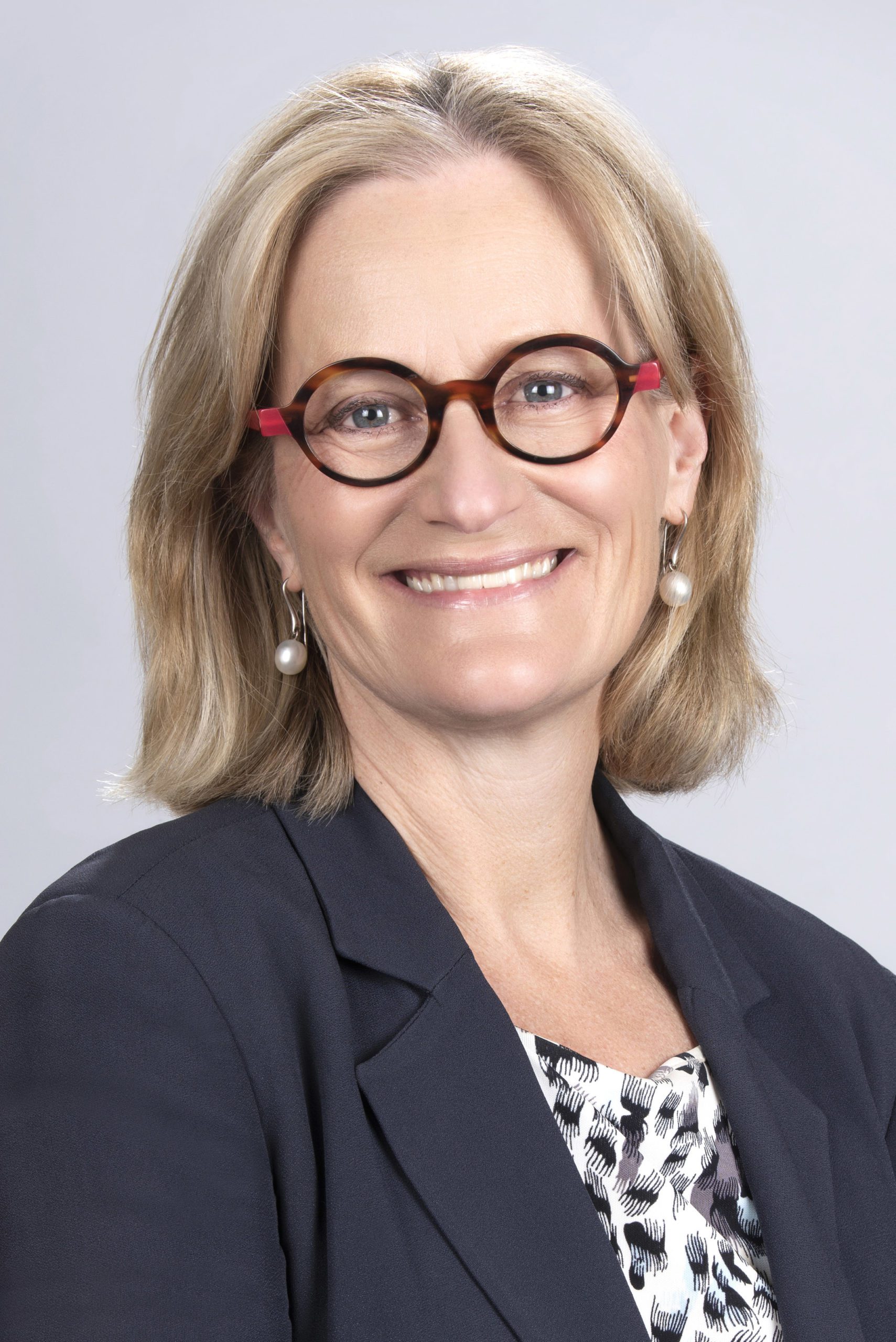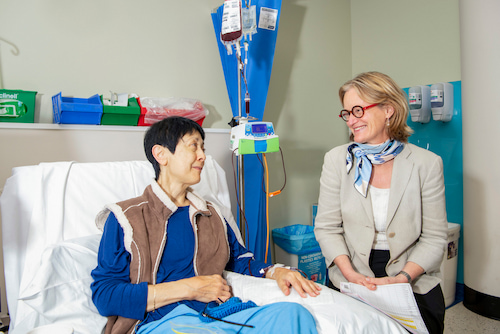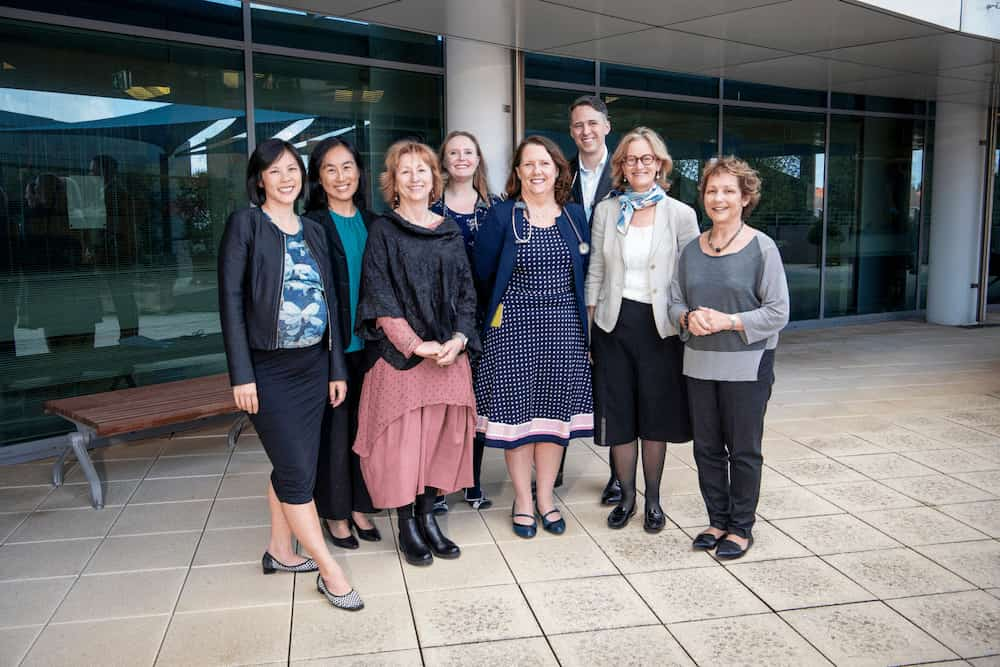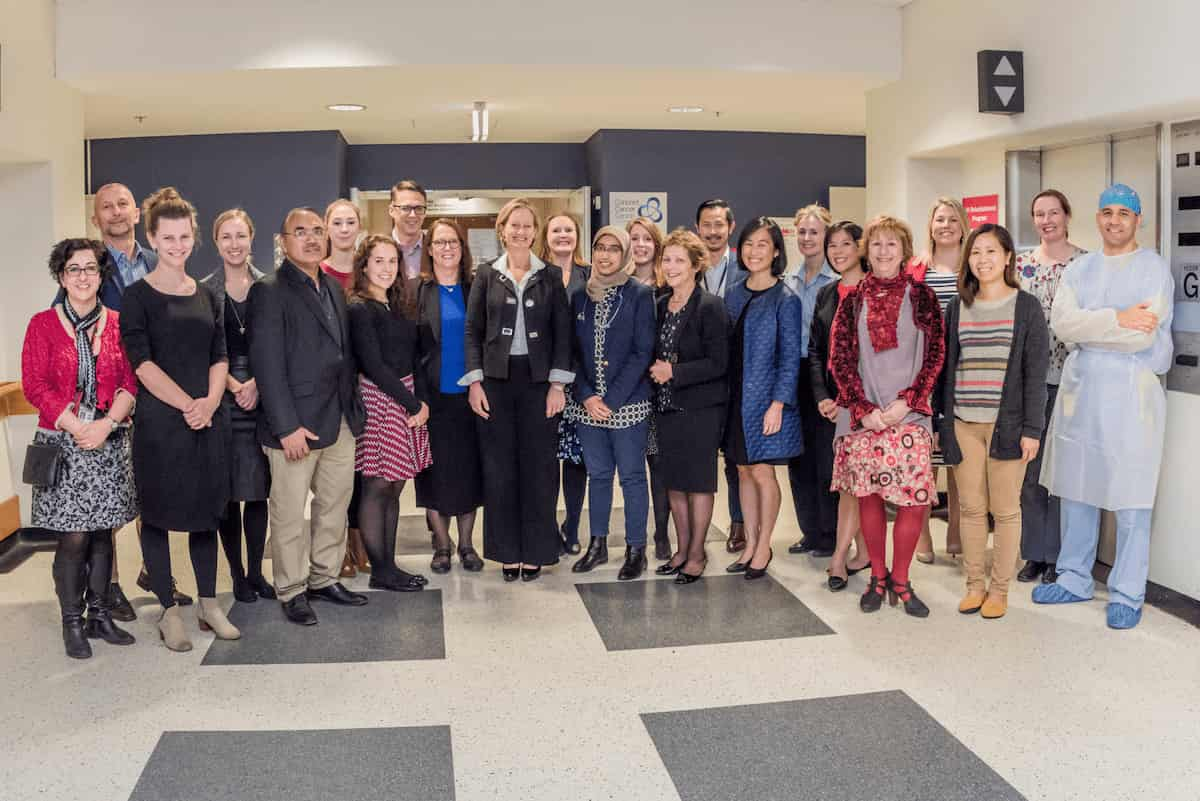Expert Series: Q&A with Professor Judith Trotman on lymphoma
Professor Judith Trotman, MBChB, FRACP, FRCPA, Grad. Cert. Clinical Trials, is Head of Haematology at Concord Repatriation General Hospital, Sydney.
A clinician researcher, she was the Founding Director of the Clinical Research Unit at Concord Hospital (Sydney) 2005 -2019. She provides global leadership in charting the role of PET scanning in lymphoma and, based on her data, was successful in obtaining an MBS listing of PET for indolent lymphomas. She has developed digital research initiatives in collaborations with patients, including ClinTrial Refer and the WhiMSICAL study, and is currently developing the My Hodgkins, My Health app. Recently, she started the new international collaborative group, Women in Lymphoma. She is a Board Member of the Australian Clinical Trials Alliance and the Foundation for A Bloody Great Cause.

Q. Why did you study medicine and specialise in haematology?
“I’d wanted to do medicine since I was a teenager. I had a serious motor vehicle accident at the age of 13 and, although I don’t remember much of the intensive care stuff, I found it fascinating being in the hospital setting. I had great training in New Zealand and was interested in HIV medicine. After doing a paediatric HIV elective in New York in 1992, I decided to come to Sydney to do HIV medicine at St Vincent’s Hospital. I found HIV absolutely tragic, but an incredibly fascinating multi-system medicine. Then I really enjoyed my haematology term and inspired by fantastic mentors I thought, ‘I’ll do haematology and HIV medicine together’. Fortunately, there became very little HIV, and I ended up doing just haematology. Lymphoma has always interested me, but I’ve always wanted to remain a generalist haematologist because I love the variety.
What really motivated me to do clinical research, as a registrar at St Vincent’s Hospital, was a woman my age, in her 20s, who had Philadelphia positive acute lymphoblastic leukemia and we battled for a couple of years to keep her alive. Back then, we had just started to get a sense of the importance of the tyrosine kinase inhibitor, imatinib, and 25+ years ago we had just started using email, through which we contacted our U.S. colleagues and desperately tried to get our hands on imatinib for this young woman, but she died before we could get it.
I remember thinking, if I was to practise as a haematologist, it would be within a big clinical research setting that was at the cutting edge, so I could access emerging new drugs for my patients. Back then, rituximab (MabThera®) was just coming out, and I remember, as a registrar, supervising a patient having their first rituximab infusion because we were so nervous about infusion reactions to rituximab. It was my first exposure to what has since been an explosion in targeted immunotherapies and biologics for blood cancers.
I’ve been very privileged to be a haematologist over the last 25 years, when there’s been so much change. Incrementally building our clinical research unit was jolly tough, but also incredibly rewarding and gave us the opportunity to contribute to global change and to be at the cutting edge for our patients, accessing Bruton tyrosine kinase (BTK) inhibitors for so many CLL and Waldenström’s patients and the PD-1 inhibitors for Hodgkin’s, immune therapies for myeloma, close molecular monitoring for CML patients, and of course PET scanning and then PET-adapted therapies for lymphoma patients. It’s just been amazing, and I couldn’t imagine practising haematology outside of a really active clinical research unit. With Dr Jane Estell’s fresh leadership at Concord Haematology’s Clinical Research Unit, we are expanding our Phase I portfolio and accessing the promising new bi-specific antibodies for myeloma and lymphoma.

A real change for me was having a year “off” in France, in 2009, when I immersed myself in the clinical trials unit at Hospital Lyon-Sud and the operations of the now French Lymphoma Study Association (LYSA). Lyon-Sud was one of the biggest lymphoma research units in Europe, but I realised that just a decade earlier it had been establishing itself like us at Concord. Being in that sort of environment makes you realise anyone can be a clinician researcher if you’ve got the will and the commitment, the people with the shared commitment beside you, and by making international connections with many colleagues.”
Q. What is Women in Lymphoma and how is this group instigating change?
“Things are changing. It’s increasingly recognised that whether viewed with a social justice or a business lens, gender equality is imperative. There’ll be a huge amount of change with this amazing group of women from all over the world who will increasingly collaborate. Women in Lymphoma (WiL) may have been catalysed by Australians, I’m the Chair and Eliza Hawkes from Monash also is on the steering committee, but it is a global initiative. Our mission is to support and advocate for greater leadership of women in lymphoma by inspiring and empowering women in lymphoma care, research, and teaching. We plan to map the metrics of their engagement and, with wit and grit, be a collective voice to encourage productive diversity in lymphoma leadership internationally, not just on behalf of women in lymphoma, but all lymphoma clinicians, researchers, and patients. Some British colleagues emailed WiL about the European School of Haematology’s How to Diagnose and Treat Lymphoma series; only one of the 42 speakers was a woman. That’s 2.5%! The WiL initiative, which had by then formed a steering committee, established governance, a website (womeninlymphoma.org) and 130 members, wrote to the ESH. Nothing changed, so we set up our own free WiL Education Series. Our first five-week series, in early-September, was on diffuse large B-cell lymphoma (DLBCL), and our first lecturer was Professor Sonali Smith (Chicago), and 86 people attended via Zoom. The entire series was a huge networking and educational success, to be followed by a Hodgkin Series in 2021.”
Q. What do you consider your career highlights?
“There are so many individual patient highlights with milestones achieved, but career-wise it would be my global leadership in PET lymphoma, in particular PET in follicular lymphoma (FL), and establishing PET as the gold-standard imaging modality for staging and response assessment of FL. It provides a platform for PET-adapted trials, designed to improve outcomes and develop an individualised approach for patients. Being able to translate the global data into access to PET locally for patients with low grade (indolent) lymphoma in Australia was just as important to me. Kiwis to follow, hopefully.
Being a part of enhancing and increasing the Australasian Leukaemia & Lymphoma Group’s international collaborations. I’ve really enjoyed our collaboration with the RATHL (Response Adapted Therapy in Hodgkin Lymphoma) study, with the UK National Cancer Research Institute, and the REMARC study with the French lymphoma group, LYSA. It’s been an absolute privilege to participate in the iNNOVATE Phase III trial with ibrutinib, the first BTK inhibitor for Waldenström’s, and then in the trials with zanubrutinib, the second-generation BTK inhibitor. It was amazing to see these patients, exhausted and unwell with relapsed/refractory disease, who were running out of options, take these incredibly well-tolerated oral agents and literally get up off their beds and live healthy lives.
The first BTK inhibitor had minor side-effects. But compared to a life living with or dying from refractory Waldenström’s, any of us would be happy to put up with a bit of bruising, arthritis and diarrhoea. And the second-generation BTK inhibitors, like zanubrutinib (Brukinsa®, formerly BGB-3111), have an even better toxicity profile. It changed the whole mentality around progression-free survival (PFS) being the most important (surrogate parameter) for overall survival (OS) because these drugs are a switch; they switch off the activity of the Waldenström’s or CLL. Studies like MURANO, and accessing venetoclax (Venclexta®) for our patients with CLL, have also been a privilege, to access all these incredibly well-tolerated and potentially time limited oral therapies that are keeping people out of hospital, keeping people alive, and living well; not just flogging people with repeated rounds of salvage chemotherapy. I’m so pleased I haven’t had to use toxic drugs like fludarabine for years.
Getting access to either brentuximab vedotin (Adcetris®), an anti-CD30 antibody-drug conjugate, or the PD-1 inhibitor, pembrolizumab (Keytruda®), an immunomodulatory antibody which harnesses the patient’s own immune response, in the KEYNOTE studies for Hodgkin lymphoma (HL). (Our lead investigator at Concord was Dr Robin Gasiorowski). It was quite amazing to witness young patients with refractory (resistant) HL respond so well and tolerate these smarter treatments so much better than blunderbuss chemotherapy. I don’t want to sound like a Pollyanna–we still have to use pretty intensive chemotherapy for many lymphomas–but there’s a real recognition of the fact that we’re getting a better understanding of the biology, and how we can interfere with the pathways that are driving the lymphoma proliferation. With greater sub-classification of lymphomas though collaboration between clinicians and patients, niche clinical trials for specific lymphomas will be even more important. And the immune revolution for patients is not restricted to lymphoma; our patients have accessed so many new antibodies for myeloma (daratumumab, elotuzumab) through the myeloma trial portfolio lead by Dr Jane Estell.”

Q. What do you consider is the greatest unmet need in lymphoma?
“Every different lymphoma histology has its own unmet need. Every different patient has their own unmet need and different priorities. In DLBCL, being able to identify and get better therapies for the poor prognosis patient is certainly an issue. We have various prognostic indices, but they’re not perfect. That’s clearly an unmet need. In FL, we’ve got this real focus on ‘progression-free survival’ as we develop new therapies. But I think that while PFS is absolutely a really important metric, it’s not always a surrogate for OS as the key metric, and with patients living so much longer, we can’t even easily and rapidly map PFS differences out with short-term clinical trials. We need a better surrogate for OS. I think it’s also about patients’ quality of life, and I think, finally, there is a growing recognition that patient reported outcomes measures are really, really important.
While we focus on PFS, because obviously that’s a key priority for industry and it’s a key priority for us too, we’ve got to have more of the patient voice engaged in setting the priorities. That’s why we (Ibrahim Tohidi-Esfahani and I, with the WMozzies and IWMF patient investigators) created WhiMSICAL. That’s why Gajan Kailainathan, Janlyn Falconer and I are building the My Hodgkin My Health App for long-term follow-up of patients. The challenge is that the patient voice is not just one voice; there are so many different unmet needs and different priorities. While a cure is priority #1 for many, for other patients, controlling their disease is the main priority; particularly for some older patients if they can control their lymphoma while living well without, or with minimal, side-effects of therapy. Yet, other older patients may say that’s very paternalistic/maternalistic of me to say that; they want cures too! Balancing the efficacy and toxicity of novel therapies was a key aspect of Dr Emma Verner’s ALLG IRiC study of Ibrutinib and Rituximab-Mini-CHOP in elderly patients with DLBCL. It’s really hard to say what’s the greatest unmet need.”
Q. What’s the most important news in lymphoma research at the moment?
“You know what? I don’t know. Perhaps the data showing that patients on the PD-1 inhibitor pembrolizumab are doing even better than brentuximab (another great antibody-driven therapy) in the relapsed Hodgkin’s setting, so I eagerly await the final KEYNOTE publication which shows that patients with relapsed and resistant HL are surviving for years on pembrolizumab. Our own Phase I-III zanubrutinib data, developed with our colleagues across Australia and globally, is now published in the journal Blood, revealing the very high (96%) response rates and long-term excellent tolerance of zanubrutinib for the treatment of patients with WM, is of course a favourite of mine. It’s really hard to know, particularly because everyone’s so focused on COVID at the moment. People haven’t been attending meetings as much.
COVID has completely transformed the whole way we manage our patients. And everyone’s tired, not just the Melbourne clinicians. And the patients are so fearful; so many of them have just gone into lockdown. They’re shielding themselves. COVID changed the way we operate, with telehealth. You can do a few telehealth appointments, but after a while you do need to see the patient face-to-face. You need to feel their lymph nodes and see their reactions and get a sense of what their anxieties and their worries are. Most patients are needing treatment for lymphoma, that’s the overriding priority, not COVID. But I expect, particularly for a lot of patients in certain hospitals in Melbourne, and in Europe and around the U.S., there are huge anxieties in coming in and having treatment. We had our own patients fearful of coming in when we had a very small, (and I’m proud to say), well contained outbreak at Concord. I recently reviewed a large overseas cohort of lymphoma patients infected with COVID and there are specific factors that may be associated with higher mortality risks, but I can’t share the data yet because it’s in press.” We are learning on the run with COVID.

Q. The NHL30* (PETReA) study is part of the Leukaemia Foundation’s Trials Enabling Program. How is it progressing?
“This is a 1200-patient study using a PET response to adapt ongoing treatment for patients after their induction therapy for what’s called high tumour burden FL. It’s a UK-linked study and the principal investigators in Australia are Dr Anna Johnston, in Tasmania, at the Royal Hobart, and me.
It’s effectively two clinical trials in parallel. After a patient has received antibody and chemotherapy treatment for their FL, they have a PET scan. On the basis of data in other clinical trials, for 80% of those patients the PET scan will become negative, and there will be no signs of any metabolic activity of the lymphoma in their body. Now in those patients, we are randomising them to antibody maintenance (rituximab/obinutuzumab [Gazyva®]), compared to no antibody maintenance. We predict that antibody maintenance given every two months for the following two years, even in the PET-negative will prolong PFS, but not their OS. It will keep the patient in remission for longer. But it comes at the price of increased toxicity, particularly increased troublesome infections like sinusitis, bronchitis, and respiratory tract infections. FL is generally seen as an incurable lymphoma, and when the patient relapses after antibody maintenance they don’t have as long a remission the second time round because they’ve already been exposed to a lot more antibody. So there are swings and roundabouts, there are trade-offs from this antibody maintenance. Firstly, what we’re wanting to do is to quantitate that trade-off in the patients who have the best prognosis, those who have become PET-negative after their initial antibody chemotherapy treatment. Secondly, less than one in five (<20% of the patients) will still have signs of glucose uptake attributed to the lymphoma on the PET scan, and we know these patients who remain PET-positive have a much worse prognosis. We know they are more likely to relapse much earlier and are >5 times more likely to die earlier because of their lymphoma. This is one of the real appeals of the PETReA NHL30 study, because in this PET-positive population, half of them are receiving the (rituximab or obinutuzumab) antibody maintenance, and half of them are going to have lenalidomide (an immune modulatory agent which harnesses the activity of their own immune system to fight the lymphoma) added to the antibody maintenance.
So, to summarise PETReA, we’re measuring the benefits and toxicities of maintenance in patients who become PET-negative, and the likely benefit and toxicity of additional lenalidomide in patients who are PET-positive. We’re trying to work out a PET-adapted approach; a specific personalised medicine approach for individual patients, rather than one-size-fits-all, where you give everybody intensive antibody-chemotherapy and ongoing treatment with antibody maintenance, which we know has significant toxicity.
So, significant benefits, but significant toxicity, and indeed in the very old, people over the age of 70, they’ve got a much higher risk of dying on antibody maintenance after drugs like bendamustine (Treanda®). There’s no point getting a complete response of your lymphoma and then dying of an infectious toxicity because of the treatment.
We’ve been in the study for about a year now and we’ve recruited 30 patients in Australia out of about 150 patients worldwide. We put it on hold initially with COVID, then we realised, with COVID, this study is even more important, because there’s potentially an even higher risk of toxicity of the maintenance antibody in the COVID setting. We genuinely don’t know, and that’s the setting where clinical trials are vital to advancing lymphoma care.”
Q. How important is the funding from the Leukaemia Foundation for the NHL30 study?
“The Leukaemia Foundation funding was a great enabler. While we got some funding for the study from the MRFF [Medical Research Future Fund], to get access to the trial for a decent number of patients across 15 sites, we needed more funding. And this helps not just current but future patients access clinical trials. By being able to contribute well patients to the UK RATHL study, we have had access to PETReA and soon we hope the RADAR study for patients with early stage HL, in 2021. We also then get access to new studies and new treatments for our patients. Maintaining these international collaborations is how you get access to new treatments. They really are.”
A previous study Professor Trotman was involved in received a $340,000 grant from the Leukaemia Foundation titled: RATHL – Randomised Phase III trial to a assess response adapted therapy using PET in newly diagnosed advanced HL, the results of which were published in the world-leading New England Journal of Medicine in 2016 – the day of the Brexit vote!
Last updated on January 3rd, 2023
Developed by the Leukaemia Foundation in consultation with people living with a blood cancer, Leukaemia Foundation support staff, haematology nursing staff and/or Australian clinical haematologists. This content is provided for information purposes only and we urge you to always seek advice from a registered health care professional for diagnosis, treatment and answers to your medical questions, including the suitability of a particular therapy, service, product or treatment in your circumstances. The Leukaemia Foundation shall not bear any liability for any person relying on the materials contained on this website.